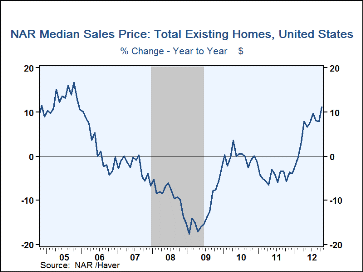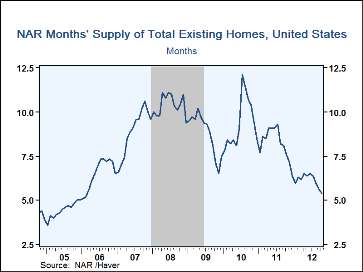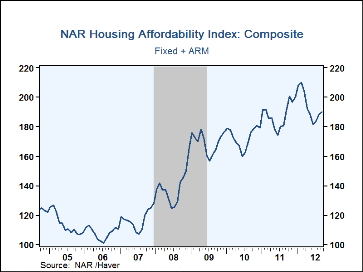 Global| Nov 19 2012
Global| Nov 19 2012U.S. Existing Home Sales Improve
by:Tom Moeller
|in:Economy in Brief
Summary
The National Association of Realtors reported that sales of existing homes increased 2.1% during October to a 4.790M annual rate. The gain followed a downwardly revised 2.9% September decline to 4.690M, initially reported as 4.750M. [...]
The National Association of Realtors reported that sales of existing homes increased 2.1% during October to a 4.790M annual rate. The gain followed a downwardly revised 2.9% September decline to 4.690M, initially reported as 4.750M. The latest compared to Consensus expectations for 4.75M sales. Sales of existing single-family homes alone rose 1.9% to 4.220M, up 9.6% y/y. (These data have a longer history than the total sales series). Sales of condos and co-ops rose 3.6 m/m to 0.570M, up 21.3% y/y.
Home pricing improved slightly. The median price of an existing home ticked up 0.2% (+11.1% y/y) to $178,600 following three straight months of decline. In the West, the median price rose 21.2% y/y to $242,100. In the Northeast, the median sales price of $232,600 was up 4.6% y/y. In the South, the price of $152,200 was up 8.2% y/y and in the Midwest the price rose 10.6% y/y to $145,600.
The supply of homes on the market fell to a six year low of 5.4 months. The months' supply of single-family homes on the market slipped to 5.4 and for condos & coops it fell to 5.3 months. The total number of homes on the market continued its steady decline and fell 1.4% m/m, down 21.0% y/y. Inventories of single-family homes fell 20.9% y/y while inventories of multi-family homes fell 26.9%.
Reported earlier this month, the composite index of home price affordability rose slightly for the third consecutive but slipped 0.5% y/y. Mortgage payments as a percent of income slipped m/m to 13.2% versus the high of roughly 25.0% in 2006. The average monthly mortgage rate ticked down to 3.68%.
The data on existing home sales, prices and affordability can be found in Haver's USECON database. The regional price, affordability and inventory data are available in the REALTOR database. The expectations figure is in the AS1REPNA database. Estimating a Structural Model of Herd Behavior in Financial Markets from the Federal Reserve Bank of New York can be found here.
Good Intentions in the Short Term with Risky Consequences for the Long Term is the title of last week's speech by Charles I. Plosser, President and CEO of the Federal Reserve Bank of Philadelphia and it can be found here.
| Existing Home Sales (Thous, SAAR) | Oct | Sep | Aug | Y/Y% | 2011 | 2010 | 2009 |
|---|---|---|---|---|---|---|---|
| Total | 4,790 | 4,690 | 4,830 | 10.9 | 4,283 | 4,181 | 4,329 |
| Northeast | 580 | 590 | 630 | 13.7 | 544 | 563 | 580 |
| Midwest | 1,110 | 1,090 | 1,110 | 18.1 | 920 | 908 | 975 |
| South | 1,920 | 1,880 | 1,920 | 11.0 | 1,685 | 1,626 | 1,640 |
| West | 1,180 | 1,130 | 1,170 | 3.5 | 1,133 | 1,083 | 1,134 |
| Single-Family Sales | 4,220 | 4,140 | 4,290 | 9.6 | 3,797 | 3,704 | 3,868 |
| Median Price, Total, ($, NSA) | 178,600 | 178,300 | 184,900 | 11.1 | 164,542 | 172,442 | 172,783 |
Tom Moeller
AuthorMore in Author Profile »Prior to joining Haver Analytics in 2000, Mr. Moeller worked as the Economist at Chancellor Capital Management from 1985 to 1999. There, he developed comprehensive economic forecasts and interpreted economic data for equity and fixed income portfolio managers. Also at Chancellor, Mr. Moeller worked as an equity analyst and was responsible for researching and rating companies in the economically sensitive automobile and housing industries for investment in Chancellor’s equity portfolio. Prior to joining Chancellor, Mr. Moeller was an Economist at Citibank from 1979 to 1984. He also analyzed pricing behavior in the metals industry for the Council on Wage and Price Stability in Washington, D.C. In 1999, Mr. Moeller received the award for most accurate forecast from the Forecasters' Club of New York. From 1990 to 1992 he was President of the New York Association for Business Economists. Mr. Moeller earned an M.B.A. in Finance from Fordham University, where he graduated in 1987. He holds a Bachelor of Arts in Economics from George Washington University.










